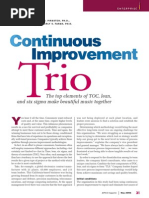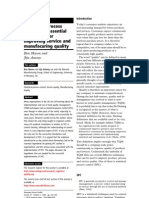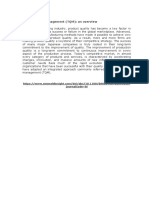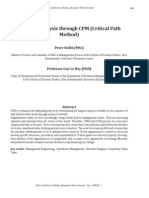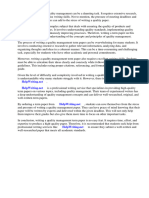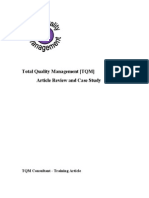Unesco - Eolss Sample Chapters: Principles and Tools of Total Quality Management
Unesco - Eolss Sample Chapters: Principles and Tools of Total Quality Management
Uploaded by
Kin SkyeCopyright:
Available Formats
Unesco - Eolss Sample Chapters: Principles and Tools of Total Quality Management
Unesco - Eolss Sample Chapters: Principles and Tools of Total Quality Management
Uploaded by
Kin SkyeOriginal Title
Copyright
Available Formats
Share this document
Did you find this document useful?
Is this content inappropriate?
Copyright:
Available Formats
Unesco - Eolss Sample Chapters: Principles and Tools of Total Quality Management
Unesco - Eolss Sample Chapters: Principles and Tools of Total Quality Management
Uploaded by
Kin SkyeCopyright:
Available Formats
U
N
E
S
C
O
E
O
L
S
S
S
A
M
P
L
E
C
H
A
P
T
E
R
S
SYSTEMS ENGINEERING AND MANAGEMENT FOR SUSTAINABLE DEVELOPMENT - Vol. II - Principles and Tools of
Total Quality Management - Melsa, J . L.
Encyclopedia of Life Support Systems (EOLSS)
PRINCIPLES AND TOOLS OF TOTAL QUALITY MANAGEMENT
Melsa, J. L.
College of Engineering, Iowa State University, USA
Keywords: Quality, Quality Management, Benchmarking
Contents
1. Introduction
2. Total Quality Management Tools
3. Total Quality Management Philosophies
3.1 Visionary Leadership
3.2 Customer Driven Excellence
3.3 Agility
3.4 Organizational and Personal Learning
3.5 Management by Fact
3.6 Valuing Employees and Partners
3.7 Focus on the Future
3.8 Managing for Innovation
3.9 Social Responsibility
3.10 Focus on Results and Creating Value
3.11 Systems Perspective
Glossary
Bibliography
Biographical Sketch
Summary
Quality improvement and cycle time reduction are no longer fads or slogans but have
become the survival issues of the 21
st
century. Companies that have adopted quality
management practices have experienced an overall improvement in corporate
performance including better employee relations, higher productivity, greater customer
satisfaction, increased market share, and improved profitability. While each company
developed its practices in a unique environment with its own opportunities and
problems, there were common features in their quality management systems. These
features included corporate focus on meeting customer needs, management that led the
way, the empowerment of employees to seek continuous process improvement, a
flexible and responsive corporate culture, fact-based decision making, and partnerships
with suppliers. It is important to note that many different kinds of companies benefited
from putting specific TQM practices in place; however, none of these companies reaped
those benefits immediately. Allowing sufficient time for results to be achieved was as
important as initiating a quality management program.
Often when people talk about how they truly embraced the TQM strategy, they talk
about a compelling event. This is often driven by a crisis such as the massive lost of
business to major competitors or a significant drop in profitability. Companies such as
U
N
E
S
C
O
E
O
L
S
S
S
A
M
P
L
E
C
H
A
P
T
E
R
S
SYSTEMS ENGINEERING AND MANAGEMENT FOR SUSTAINABLE DEVELOPMENT - Vol. II - Principles and Tools of
Total Quality Management - Melsa, J . L.
Encyclopedia of Life Support Systems (EOLSS)
Motorola and Xerox adopted the TQM journey after experiencing sharp competition
from several J apanese companies. The big-three automakers in the United States began
to embrace TQM after they had lost significant market share to Honda and Toyota.
Others have embraced the TQM philosophy based on a motivating vision. For example,
Disney has used the vision: "The Happiest Place on the Earth," to motivate employees
to new heights of customer satisfaction. While a crisis creates stress, a motivating
vision creates opportunity or romance. In either case, the most important issue for
success is to have a resolve to make things be different.
In summary, there is no magic formula to success in the quality journey. The work
needed to implement TQM may, in many cases, seem unnatural in the sense that it is
very different than anything that one has been led to believe is true. One will have to
begin doing some new things, and, perhaps even more importantly, stop doing some old
things. It is clear that one must allow sufficient time for results to be achieved. Don't
expect instantaneous results, although there is always some low-hanging fruit that
will give positive reinforcement. It is important to allow sufficient time for results to be
achieved. This is a journey of unending length, but it is critical to start immediately.
This article provides a summary of total quality management for systems engineering
and management.
1. Introduction
Quality is a very misunderstood concept. To many, improved quality means that there
must be more inspection. Others believe that the only important quality issues have to
do with manufacturing operations. There has been a strongly held belief that quality
costs both time and money. Some organizations would argue that if one wants a higher
quality product, it will take longer to design and manufacture and it will cost more.
Interestingly, all of these beliefs have been proven to be wrong. Inspection does not
improve quality, and it turns out that real quality issues pervade the entire organization.
Finally, many companies are now demonstrating that high-quality products can be
produced more rapidly and at a lower cost.
A study of the Profit Impact of Market Strategies (PIMS) Data Base [The PIMS Letter
on Business Strategy, 1986], which contains financial and strategic information for
around 3000 businesses over a twenty year period, indicates that in the long run, the
most important single factor affecting a business unit's performance is the quality of its
products and services relative to those of its competitors. The study goes on to point out
that:
Businesses that offer premium quality products and services usually have large
market shares and are early entrants into their markets. The clear conclusion is
that quality does not cost time!
Quality is positively and significantly related to a higher return on investment
for almost all kinds of products and market situations. Companies with superior
relative quality receive almost three times the return on investment (ROI) as
compared with those companies with inferior relative quality (7% vs. 20%).
U
N
E
S
C
O
E
O
L
S
S
S
A
M
P
L
E
C
H
A
P
T
E
R
S
SYSTEMS ENGINEERING AND MANAGEMENT FOR SUSTAINABLE DEVELOPMENT - Vol. II - Principles and Tools of
Total Quality Management - Melsa, J . L.
Encyclopedia of Life Support Systems (EOLSS)
Product quality is an important determinant of business profitability. High
quality producers can usually charge premium prices for their products. As we
will see later, by using the right processes, quality products can, in fact, be made
at a lower cost. As a result, it is clear that quality does not cost money!
A 2002 study done by the National Institute of Standards and Technology (NIST)
[NIST, 2002], the governmental agency responsible for the Malcolm Baldrige National
Quality Award (MBNQA) award program, shows that quality management can result in
impressive financial returns. NIST invested a hypothetical sum of money in the
Standard & Poors (S&P) 500 and in each of the publicly traded companies (two whole
companies and 18 parent companies of subsidiaries) who have won the MBNQA since
1991. The investment was tracked from the first business day in April of the year the
Baldrige winner received the award, or the date they began publicly trading, through to
December 3, 2001. As a group, the companies outperformed the S&P 500 by greater
than 3 to 1. NIST also reports [NIST 2003] that Baldrige winners exhibit such attributes
as higher growth rates, better customers and employee satisfaction, and increased
market share and repeat business.
Total quality management involves both quantitative methods and human resources.
Total quality management integrates fundamental management techniques, existing
improvement efforts, and technical tools. It is important to understand this duality of
tools (quantitative and decision-making methods) and philosophy (people issues).
Doing one without the other will not be successful. The integration of tools and
techniques is critical if TQM is to be something other than an overlay program. The
next two sections of this article elaborate on these two interrelated concepts tools and
philosophy.
2. Total Quality Management Tools
There are a wide range of TQM tools; the size of this article does not permit a detailed
discussion of them along with appropriate examples. The following is a list of widely
used tools. There is no tool that is best for every application; the knowledgeable
practitioner is aware of a rich variety of tools and uses the appropriate one(s).
Process maps: One of the important keys to understanding how to improve a
process is to map the process. While there are several different approaches to
process mapping, the key is to determine who does what at each step of the process.
Often, the simple drawing of a process map is sufficient to solve many quality
problems because the map makes it so obvious where defects can be introduced.
Poke-A-Yoke: This concept of the J apanese management philosophy is to make
a process foolproof. The idea is to design the process in such a way that it is self-
checking or incorporates process steps that cause immediate detection and possible
correction of any defect. Simple examples include color-coding and special keying
of parts to ensure that they are assembled the correct way.
Statistical Tools: One of Demings major contributions to the quality movement
was the introduction of statistically grounded approaches to the analysis of defects.
Without the use of these tools, one can often make incorrect decisions regarding the
U
N
E
S
C
O
E
O
L
S
S
S
A
M
P
L
E
C
H
A
P
T
E
R
S
SYSTEMS ENGINEERING AND MANAGEMENT FOR SUSTAINABLE DEVELOPMENT - Vol. II - Principles and Tools of
Total Quality Management - Melsa, J . L.
Encyclopedia of Life Support Systems (EOLSS)
cause of a problem. This can often lead to exactly the opposite effect of that being
sought. Included in this set of tools are statistical process control (SPC) charts,
Pareto Charts, and histograms.
Force Field Analysis: This tool asks one to diagram the forces (policies, culture,
and so forth) that are resisting a desired change and the forces that support the
change. This assists one in clearly determining the degree of difficulty of making
change and exactly where effort will be needed. The supporting forces are places
where assistance can be expected.
Root Cause Analysis (Five Whys): The J apanese popularized this tool. It consists
of asking a series of questions (whys) until one uncovers the root cause of a
defective product. The objective is to determine why a defective product was
produced; this is to be contrasted with the usual approach of just fixing the defective
product or replacing it.
Fishbone Diagram (Ishakawa Diagram): This tool is also called a cause-and-
effect diagram. It is used in a brainstorming session to examine factors that may
influence a given situation or outcome. The causes are often grouped into categories
such as people, material, method or process, and equipment. The resulting diagram
takes the shape of a fishbone, hence the name.
Loss Functions: In many manufacturing situations, one creates tolerance limits for
a product. Products that fall outside of the limits are defective and those that are
inside the limits are deemed good. Several difficulties arise with this approach.
First, there is always the temptation to reclassify products that are just outside the
limits into the acceptable category, especially if there is a great push for quantity.
Second, and perhaps more important, the accumulative effect of several parts which
are all on the extreme limits of acceptability, may lead to defective performance.
The loss function tool is used to recognize that there is a cost associated with any
deviation from the ideal value.
The Plan-Do-Check-Act (PDCA) Cycle: This tool is also known as the Shewhart
Cycle. Deming popularized it in J apan; as a result the J apanese refer to it as the
Deming Cycle. The tool emphasizes a new plan for change. It carries out tests to
make the change on a small scale, observes the effects, and finally, studies the
results to determine what has been learned. The cycle is repeated as needed.
Brainstorming: This process has become a staple of the TQM movement. The
concept is to invite participants to suggest solutions to a problem without any
evaluation of the usefulness or correctness of their ideas. Several approaches are
possible, including open suggestions, rotating suggestions, or blind suggestions.
There are several computer tools that have been developed to assist in this process.
After a fixed period of time, or after all suggestions have been made, there is
discussion of the value of the suggestions.
Affinity Diagram: The affinity diagram tool is used to organize large amounts of
non-quantitative (ideas, opinions, issues, etc.) information into groupings based on
natural relationships between the items. It is largely a creative rather than a logical
process. In a very loose sense, the affinity diagram does for ideas what statistics
does for numbers, viz. extract meaning from raw data. The affinity diagram process
is often used with the results of a brainstorming session to organize the resulting
ideas.
Interrelation Digraph: This tool takes complex, multi-variable problems, or
U
N
E
S
C
O
E
O
L
S
S
S
A
M
P
L
E
C
H
A
P
T
E
R
S
SYSTEMS ENGINEERING AND MANAGEMENT FOR SUSTAINABLE DEVELOPMENT - Vol. II - Principles and Tools of
Total Quality Management - Melsa, J . L.
Encyclopedia of Life Support Systems (EOLSS)
desired outcomes, and explores and displays all of the interrelated factors involved.
It graphically shows the logical and often causal relationship between factors. It is
often used in conjunction with the results of an affinity diagram exercise to seek
causes and effects in order to determine why corrective action needs to be applied.
Tree Diagram: This tool is used to systematically map out, in increasing detail, the
full range of paths and tasks that need to be accomplished to achieve a primary goal
and every related sub goal. Graphically, it resembles an organization chart or family
tree.
Prioritization Matrices: Prioritization matrices are one of a group of decision-
making tools that help to prioritize tasks, issues, or possible actions on the basis of
agreed upon criteria. While these tools cannot make decisions, they can help to
ensure that all factors are evaluated and that logical decisions are reached.
Activity Network Diagram: This class of tools includes a wide range of project
management tools used to plan the most appropriate schedule for a complex project.
Typical examples are Gantt Charts and PERT charts. These tools project likely
completion time and associated effects and provide a method for judging
compliance with a plan. Several excellent computer programs exist for automating
the work associated with this class of tools.
3. Total Quality Management Philosophies
The core values and concepts of the Criteria for Performance Excellence of the Baldrige
National Quality Program [NIST, 2006] form an excellent framework for understanding
the philosophies of Total Quality Management.
In addition, the Criteria provide an excellent tool for measuring an organizations
performance against a well-calibrated standard. As outlined in the Criteria, the TQM
philosophy involves eleven interrelated concepts:
1. Visionary Leadership
2. Customer-Driven Excellence
3. Agility
4. Organizational and Personal Learning
5. Management by Fact
6. Valuing Employees and Partners
7. Focus on the Future
8. Managing for Innovation
9. Social Responsibility
10. Focus on Results and Creating Value
11. Systems Perspective
The following eleven sub-sections explain each of these items in more detail.
U
N
E
S
C
O
E
O
L
S
S
S
A
M
P
L
E
C
H
A
P
T
E
R
S
SYSTEMS ENGINEERING AND MANAGEMENT FOR SUSTAINABLE DEVELOPMENT - Vol. II - Principles and Tools of
Total Quality Management - Melsa, J . L.
Encyclopedia of Life Support Systems (EOLSS)
-
-
-
TO ACCESS ALL THE 18 PAGES OF THIS CHAPTER,
Visit: http://www.eolss.net/Eolss-sampleAllChapter.aspx
Bibliography
Argyris, C. (1991). Double loop learning. Harvard Business Review. 68(5), 99-109. [A classic and
seminal paper concerning how people learn well and poorly.]
Blanchard, K. & Bowles. S. (1993). Raving Fans. New York: William Morrow and Company, Inc.
[This book discusses how to successfully cultivate organizational customers.]
Brassard, M. (1989). The memory jogger plus+. Methuen, MA: GOAL/QPC. XXX [This book
presents a variety of tools useful in the application of TQM.]
Collins, J . (2001a). Level 5 leadership: the triumph of humility and fierce resolve. Harvard Business
Review. 79(1), 67-76. [An excellent paper on leadership characteristics.]
Collins, J . (2001b) Good to Great, New York: Harper Business. [This book describes in detail the factor
that make some companies become great.]
Collins, J . (2005) Good to Great and the Social Sectors, Boulder Colorado: J im Collins. [This
monograph relates the Good to Great concepts to not-for-profit organizations.]
Drucker, P. F. (1993). Post capitalist society. New York: Harper Business Publishers. [A classic book
on the knowledge society.]
Garvin, D. A. (1993). Building a learning organization. Harvard Business Review. 71(4), 78-91. [A
classic paper on learning organizations.]
Hammer, M. & Champy, J . (1993). Reengineering the corporation. New York: Harper Collins
Publishers, Inc. [A classic work on business process reengineering.]
Hammer, M. (1990). Reengineering work: dont automate, obliterate. Harvard Business Review. 67(4),
104-112. [A seminal paper on business process reengineering.]
Heskett, J . L. (1987). Lessons in the service sector. Harvard Business Review. 64(2), 2-11. [This paper
discusses the value chain relating employee satisfaction to company profits.]
J ones, T.O. & Sasser, W. E. J r. (1995). Why satisfied customers defect. Harvard Business Review.
73(6), 89-99. [This paper indicates that customer loyalty is created by having customers who are excited,
not merely satisfied, by the performance of the product..]
Kaplan, R.S. & Norton, D. P. (1993). Putting the balance scorecard to work. Harvard Business Review.
71(5), 134-147. [A paper discussing one of the many methods useful in implementing TQM.]
Kirkpatrick, D.L. (1998). Evaluating training programs, 2
nd
ed. San Francisco: Berrett-Koehler
Publishers, Inc. [This text discusses why it is necessary to have program evaluation beyond the traditional
end of program evaluation.]
Melsa, J . L. (1999) Total Quality Management. In Sage, A. P. & Rouse, W. B. (Eds.) Handbook of
Systems Engineering and Management, J ohn Wiley and sons, New York. [This chapter presents TQM
fundamentals in a work specifically aimed at systems engineering and management.]
NIST (2002). Baldrige Award Winners Beat the S&P 500 for Eighth Year, Washington, D.C. [A website
of information regarding the Malcolm Baldrige Award.] Available at www.quality.nist.gov.]
U
N
E
S
C
O
E
O
L
S
S
S
A
M
P
L
E
C
H
A
P
T
E
R
S
SYSTEMS ENGINEERING AND MANAGEMENT FOR SUSTAINABLE DEVELOPMENT - Vol. II - Principles and Tools of
Total Quality Management - Melsa, J . L.
Encyclopedia of Life Support Systems (EOLSS)
NIST (2003) Why Apply, Washington, D.C. [A listing of several performance excellence results by
Baldrige winners.] Available at www.quality.nist.gov.]
NIST (2006). Malcolm Baldrige National Quality Award, 2006 Award Criteria. Washington, D.C. [A
list and discussion of the criteria for the Baldrige Award. Available at www.quality.nist.gov.]
ODell, G & Grayson, C. J . J r. (1998). If only we knew what we know. New York: The Free Press [An
interesting text on knowledge management and quality.]
Peters, T. (1987). Thriving on chaos. New York: Alfred A. Knopf. [A classic work relating to quality.]
Reichheld, F. F. & Sasser, W. E., J r. (1990). Zero defections: quality comes to services. Harvard
Business Review. 67(5), 105-113. [Discussion of quality in the service industry.]
Sage, A. P. (1995) Systems management for Information Technology and Software Engineering, J ohn
Wiley and Sons, New York. [Contains several chapters on quality management, learning organizations,
reengineering and other subjects in systems engineering and management applied to information
technology and software engineering.]
Schonberger, R. J . (1986). World class manufacturing. New York: The Free Press. [A discussion of
quality in manufacturing.]
Senge, P. M. (1990). The fifth discipline. New York: A Currency Book. [A highly regarded work on
learning organizations.]
Smith, P. G. & Reinertsen, D. G. (1991). Developing products in half the time. New York: Van
Nostrand Reinhold. [An interesting applications oriented work on quality product development under
time constraints.]
Stayer, R. C. (1990). How I learned to let my workers lead. Harvard Business Review. 67(6), 66-83.
[An excellent discussion of employee empowerment.]
Stewart, T. A. (1991). GE keeps those ideas coming. FORTUNE. August 12, 1991, 41-49. [This is an
interesting discussion of employee empowerment and involvement.]
The PIMS Letter on Business Strategy, (1986). No. 4. Cambridge, MA: The Strategic Planning
Institute, [This work contains financial and strategic information for businesses over a twenty year period
and indicates that the most important factor affecting performance is product and service quality relative
to the competition].
Walton, M. (1986). The Deming management method. New York: A Perigee Book. [An excellent
overview of the W. Edwards Deming approach to total quality.]
Biographical Sketch
James l. Melsa, Dean Emeritus of the College of Engineering at Iowa State University, is a distinguished
scholar, an award-winning educator, and a visionary corporate leader. Dr. J ames L. Melsa served as dean
of the Iowa State University College of Engineering from 1995 to 2004. Previously, he spent 11 years at
Tellabs Inc., Lisle, Ill., including appointments as vice president of strategic planning and advanced
technology, vice president of research and development, and vice president of strategic quality and
process management.
Melsa also was on the faculty at the University of Notre Dame for 11 years, serving as professor and
chair of the electrical engineering department. He also has worked on the faculties at Southern Methodist
University, Dallas, and the University of Arizona, Tucson. During his years as an academic, Melsa
conducted significant research on control and estimation theory, speech encoding, and digital signal
processing; directed 20 masters theses and 16 Ph.D. dissertations; earned recognition as one of the
nation's outstanding electrical engineering professors; and authored or co-authored 116 publications and
12 books, including Linear Control Systems, a classic text used around the world.
He was named a fellow of the Institute of Electrical and Electronic Engineers in 1978 and received that
group's Third Millennium Medal in 2000. He was named a fellow of the American Society for
Engineering Education in 2006. He has previously served as President of the IEEE Control Systems
U
N
E
S
C
O
E
O
L
S
S
S
A
M
P
L
E
C
H
A
P
T
E
R
S
SYSTEMS ENGINEERING AND MANAGEMENT FOR SUSTAINABLE DEVELOPMENT - Vol. II - Principles and Tools of
Total Quality Management - Melsa, J . L.
Encyclopedia of Life Support Systems (EOLSS)
Society and President of Eta Kappa Nu, the national electrical and computer engineering honorary and is
currently President Elect of ASEE He has an extensive record of service to national and international
groups, including the Herbert Hoover Presidential Library Association (past trustee), the Iowa Business
Council (past deputy), and the Malcolm Baldrige National Quality Award (past member of the Board of
Examiners and the Board of Overseers). Melsa received his B.S. degree in electrical engineering from
Iowa State (1960) and his M.S. (1962), and Ph.D. (1965) degrees from the University of Arizona,
Tucson.
You might also like
- Continuous Improvement Trio (TOC, Lean and Six Sigma)100% (1)Continuous Improvement Trio (TOC, Lean and Six Sigma)3 pages
- Nobody Ever Gets Credit For Fixing Problems That Never HappenedNo ratings yetNobody Ever Gets Credit For Fixing Problems That Never Happened26 pages
- Statistical Process Control: An Essential Ingredient For Improving Service and Manufacuring QualityNo ratings yetStatistical Process Control: An Essential Ingredient For Improving Service and Manufacuring Quality6 pages
- Valerie E. Lazatin Mr. Perry David Solosa BSBAFM 3-10s BUMA 20013 Operations ManagementNo ratings yetValerie E. Lazatin Mr. Perry David Solosa BSBAFM 3-10s BUMA 20013 Operations Management5 pages
- Effective TQM Implementation Critical IssuesNo ratings yetEffective TQM Implementation Critical Issues9 pages
- Research Thesis On Total Quality Management100% (2)Research Thesis On Total Quality Management8 pages
- Total Quality Management?: Approach That Focuses On Continuous Quality Improvement of Products and Services byNo ratings yetTotal Quality Management?: Approach That Focuses On Continuous Quality Improvement of Products and Services by7 pages
- Nobody Ever Gets Credit For Fixing Problems That Never Happened (2001) PDFNo ratings yetNobody Ever Gets Credit For Fixing Problems That Never Happened (2001) PDF25 pages
- An Examination of The Application of Plan-Do-Check-Act Cycle in Product DevelopmentNo ratings yetAn Examination of The Application of Plan-Do-Check-Act Cycle in Product Development9 pages
- Question # 1 (A) Define Scope and Significance of Operation Management100% (1)Question # 1 (A) Define Scope and Significance of Operation Management11 pages
- Total Quality Management (TQM) : Management Products Services Production Just-In-Time ProductionNo ratings yetTotal Quality Management (TQM) : Management Products Services Production Just-In-Time Production12 pages
- Project Topic: The Impact of Total Quality Management On Organizational Performance. (A Case Study of Fine Coat Limited)No ratings yetProject Topic: The Impact of Total Quality Management On Organizational Performance. (A Case Study of Fine Coat Limited)73 pages
- Philippine Christian University: College of Arts, Sciences and Teacher EducationNo ratings yetPhilippine Christian University: College of Arts, Sciences and Teacher Education5 pages
- Quality Management Implementation in The Indian Automobile Industry Management EssayNo ratings yetQuality Management Implementation in The Indian Automobile Industry Management Essay14 pages
- 5 Goals For The Performance Measure PractitionerNo ratings yet5 Goals For The Performance Measure Practitioner18 pages
- Lecture 4: Quality Philosophy and Management Strategies: 1.0.1 William Edwards DemingNo ratings yetLecture 4: Quality Philosophy and Management Strategies: 1.0.1 William Edwards Deming3 pages
- Managing Change in Theory and Practice - Case Study - AnswersNo ratings yetManaging Change in Theory and Practice - Case Study - Answers18 pages
- Dissertation On Performance Management System PDF100% (1)Dissertation On Performance Management System PDF6 pages
- How to Enhance Productivity Under Cost Control, Quality Control as Well as Time, in a Private or Public OrganizationFrom EverandHow to Enhance Productivity Under Cost Control, Quality Control as Well as Time, in a Private or Public OrganizationNo ratings yet
- World Class Manufacturing: The Next Decade: Building Power, Strength, and ValueFrom EverandWorld Class Manufacturing: The Next Decade: Building Power, Strength, and Value3/5 (2)
- A BUM's Strategic Planning And Critical Thinking ApproachFrom EverandA BUM's Strategic Planning And Critical Thinking ApproachNo ratings yet
- The Range of Quality: Quality of Design Quality of Materials Quality of ProductsNo ratings yetThe Range of Quality: Quality of Design Quality of Materials Quality of Products4 pages
- Introduction To C Programming: Operators, Programming Structures, Functions, StringsNo ratings yetIntroduction To C Programming: Operators, Programming Structures, Functions, Strings17 pages

